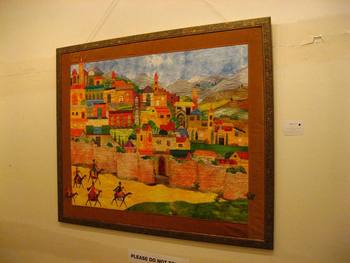Anjali Sapra’s "Timeless travel" exhibit done in Egg Tempera style is on display at Mahua Gallery, Sadashivanagar.

Egg tempera paintings by Ajnali Sapra
Anjali Sapra is an artist who is greatly influenced by Mughal architecture and the rich traditional heritage of India. She has been trained at Triveni Kala Sangam and has specialised in the art technique of vegetable dyes and other natural pigments .She has hosted a good number of shows from 2003 and some of her works are in private collections in London, Germany, USA etc. Most of her works in the "The Ephemeral Playground", "The Timeless travel" or "The Sacred Chakras" series are a depiction of man’s spiritual journey.
Did you know that paintings could be created out of eggs, to be more precise egg yolk? This art form known as Egg Tempera is as old as Early Renaissance period and was used to paint the gravestones of Egypt, Christian catacombs etc.
What is Egg Tempera technique?
It is a method of painting which uses egg yolk, water and pigment to create the paint composition. Oils, gums are also added to this medium to get greater flexibility while painting. The advantages of using egg as the medium is the complete control the painter gets over his paint and the improved quality of the paintings. Each paint stroke dries quickly and the artist is able to quickly build layers in his painting. On the downside is that the paint needs to be prepared afresh every time.
The most famous painting done by Egg Tempera technique is the "Birth of Venus" painted by Botticelli.
The paintings are on display at Mahua art gallery till Dec 31st.
Art quilting
Can fabric cum thread and needle plus sewing machine replace paint and paint brushes to create interesting art forms? Yes it can and this technique is applied in art quilting method of creating art forms.
Leela Cherian has been an art quilter from 1980. She has given solo exhibitions in US, Kuwait and in Bangalore and her works are in many private collections across the world. Her work has been showcased in HGTV and in Quilter’s newsletter, American Quilter and World of Embroidery magazines.
The quilt works comprising of all these techniques were on display at the Mahua art gallery. The art quilt forms were created by Leela Cherian. Some of the works which were on display like "Buzz in garden", "Fabled City", "Tree of Life" etc utilized these methods to create intriguing art forms.
Art quilt is basically a decorative fabric secured with stitches to intermediary cotton or poly batting (stuffing) and a back lining to form a stitched together fabric which can be hung on tapestry or walls. The decorative top layer uses many embellishments like beads, buttons, ribbons, yarns, objects, collage, photographs etc to form interesting art patterns and designs.
The various techniques used in art quilting to form decorative designs are
1. Appliqué technique: Designs are created by sewing cut pieces of different fabric on base fabric. The appliqué work can be done by hand or by machine. The appliqué work can be a collage appliqué, fused appliqué, needle appliqué, freezer paper appliqué etc. All these use different methods to create a design on to the background fabric.

Machine Applique by Leela Cherian
2. Punch needle embroidery: here various designs are created by using barbed needles. The needles are passed through fabric to create fascinating designs. No thread is used in this method.
3. Burning: here a heat gun or soldering iron is used to melt the fabric. This alters the shape of fabric creating interesting layers and textures in the design.
4. Sun printing: in this technique transparent paints are applied to the images which are placed on the fabric. The fabric is kept out in the sun. Images get printed on to the fabric through chemical reaction.
5. Fabric manipulation: Here the fabric is creased, embroidered and sculpted to form interesting shapes. The fabric is then sewn on to the base fabric.
6. Free motion embroidery: in this technique a sewing machine is used to create various designs like flower, fish etc on the fabric. The fabric is moved to and fro and the machine fills in the design using free motion.
7. Embroidery on water soluble fabric: here the same technique of free motion embroidery is done on water soluble fabric. After the design is done the piece is washed. And you are left with only the filled in thread structure on the design.
⊕